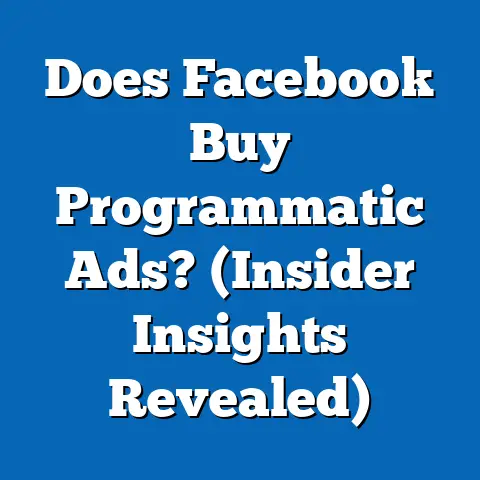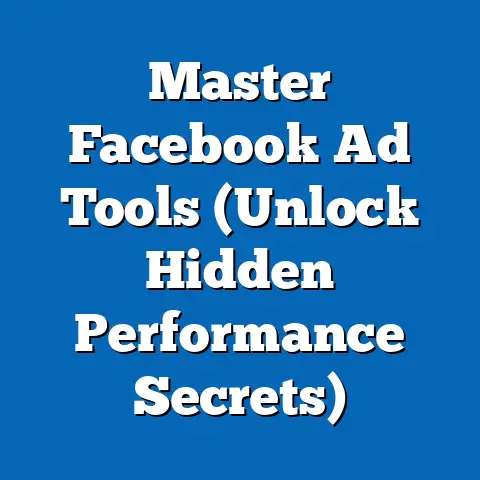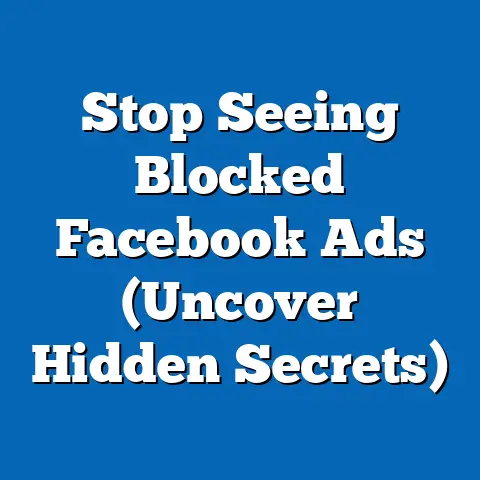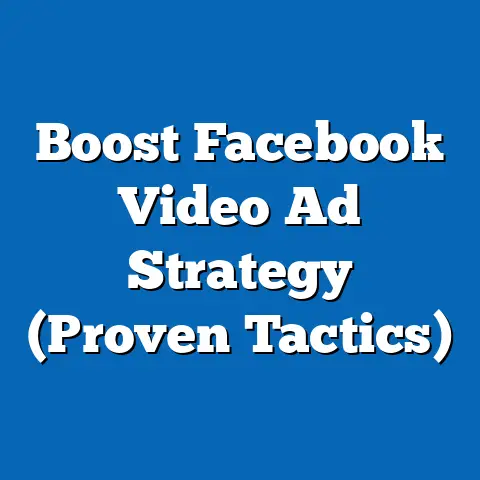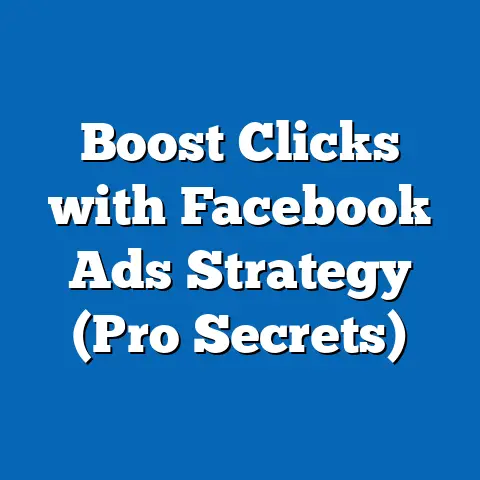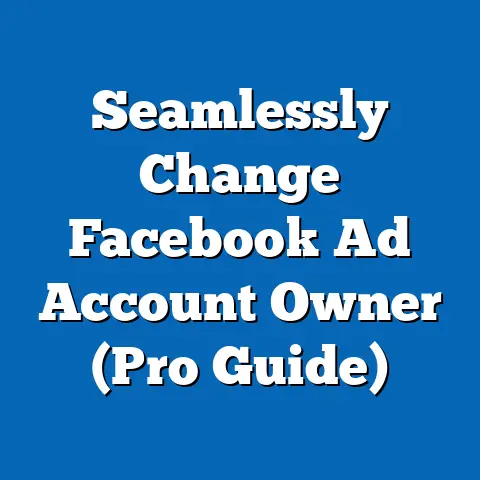Make Facebook Video Ads Engaging (Unlock Proven Strategies)
I’ve seen the digital marketing landscape evolve dramatically over the years, but one thing remains constant: video’s power to captivate an audience. And nowhere is this more evident than on Facebook. With billions of active users, Facebook presents an unparalleled opportunity for brands to connect with their target audience through video ads. The game has changed, and static images simply don’t cut it anymore.
Statistics don’t lie. According to recent reports, video content is now the most consumed type of content on Facebook, accounting for a significant portion of user engagement. Brands are catching on, increasingly shifting their focus (and budgets) to video ads. They’re realizing the potential for higher engagement rates, improved brand awareness, and ultimately, increased conversions. But simply creating a video isn’t enough. It needs to be engaging.
That’s where this guide comes in. I’m going to share proven strategies to create Facebook video ads that not only grab attention but also resonate with your audience and drive real results. Buckle up; we’re about to dive deep!
Understanding the Facebook Video Ad Landscape
First things first, let’s define what we’re talking about. Facebook video ads are, at their core, advertisements that utilize video as the primary medium. They’re strategically placed within the Facebook platform to reach a specific target audience. But they’re much more than just miniature TV commercials.
Video Ads vs. Other Ad Formats
Unlike static image ads or carousel ads, video ads offer a dynamic and immersive experience. They can tell a story, showcase a product in action, or deliver a powerful message in a way that other formats simply can’t. Image ads can certainly work, but they lack the emotional connection and depth that video can provide. Carousel ads are great for showcasing multiple products, but they don’t have the same captivating power as a well-crafted video.
Video Length, Format, and Winning Types
The ideal video length can vary depending on your objective, but generally, shorter is better. Attention spans are shrinking, so aim to convey your message concisely. Think about this: are you more likely to watch a 30-second ad or a 3-minute one while scrolling through your feed? Exactly.
Facebook supports various video formats, including MP4 and MOV. Vertical videos (9:16 aspect ratio) are particularly effective for mobile viewing, as they fill the entire screen and minimize distractions.
As for video types, some consistently outperform others:
- Live Videos: These offer a sense of authenticity and immediacy, encouraging real-time interaction. I’ve seen brands use live videos for Q&As, product demos, and behind-the-scenes glimpses.
- Stories Ads: Short, engaging videos that appear within Facebook Stories. They’re perfect for quick announcements, promotions, and showcasing your brand’s personality.
- 360-Degree Videos: These immersive videos allow viewers to explore their surroundings, providing a unique and engaging experience. I once saw a real estate company use a 360-degree video to give potential buyers a virtual tour of a property, and the results were incredible.
Aligning with the Algorithm and User Preferences
Facebook’s algorithm plays a crucial role in determining which ads users see. To maximize reach and engagement, it’s essential to align your video content with the algorithm’s preferences. This means creating videos that are:
- Relevant: Target your ads to the right audience based on demographics, interests, and behaviors.
- Engaging: Create videos that capture attention and encourage interaction, such as likes, comments, and shares.
- High-Quality: Produce videos with clear visuals, good sound, and a compelling message.
- Mobile-Friendly: Optimize your videos for mobile devices, as a significant portion of Facebook users access the platform through their smartphones.
Takeaway: Understanding the Facebook video ad landscape is the first step to creating successful campaigns. Experiment with different video lengths, formats, and types to see what resonates best with your audience.
Crafting Compelling Video Content
Now, let’s talk about the heart of your video ad: the content itself. A technically perfect video with poor content is like a beautifully wrapped gift containing… nothing. Here’s how to ensure your videos are truly compelling.
The Key Elements: Storytelling, Emotion, and Authenticity
Forget the hard sell. People are bombarded with ads every day. What they crave is connection. That’s where storytelling comes in. Craft a narrative that resonates with your audience’s values, aspirations, and pain points.
- Storytelling: Think about your brand’s story, your customers’ stories, or even a fictional story that relates to your product or service.
- Emotional Connection: Tap into emotions like joy, humor, inspiration, or even empathy. Emotion drives action. I once saw a campaign by a local animal shelter that used heartbreaking videos of abandoned animals. While sad, it was incredibly effective in driving donations.
- Authenticity: Be genuine and transparent. People can spot inauthenticity a mile away. Show the real people behind your brand, share honest testimonials, and don’t be afraid to be vulnerable.
Hooking Viewers in the First Few Seconds
Those first few seconds are critical. They’re your chance to grab attention and prevent viewers from scrolling past your ad. Think of it as your elevator pitch.
Here are some strategies for creating a killer hook:
- Ask a Question: Pose a question that immediately resonates with your target audience. For example, “Tired of struggling with [problem]?”
- Make a Bold Statement: Start with a surprising or intriguing statement that piques curiosity. “Did you know that [shocking statistic]?”
- Show a Compelling Visual: Use a visually stunning image or video clip that instantly grabs attention.
- Offer a Solution: Immediately address a common pain point and offer a solution. “Finally, a solution to [problem]!”
High-Quality Visuals, Sound, and Captions
Let’s be honest: no one wants to watch a blurry, poorly lit video with muffled audio. High-quality visuals and sound are essential for creating a professional and engaging viewing experience.
- Invest in Good Equipment: You don’t need to break the bank, but invest in a decent camera, microphone, and lighting.
- Pay Attention to Composition: Frame your shots carefully and ensure that your subjects are well-lit.
- Edit Your Videos Professionally: Use editing software to clean up your footage, add transitions, and create a polished final product.
And don’t forget captions! Many people watch videos on Facebook with the sound off, especially in public places. Captions ensure that your message is still conveyed, even without audio. They also make your videos accessible to viewers who are deaf or hard of hearing.
Takeaway: Compelling video content is the foundation of successful Facebook video ads. Focus on storytelling, emotional connection, authenticity, high-quality visuals, sound, and captions to capture attention and keep viewers engaged.
Utilizing Facebook’s Tools and Features
Facebook provides a powerful suite of tools and features that can significantly enhance the performance of your video ads. Understanding how to leverage these resources is crucial for maximizing your ROI.
The Ads Manager, Audience Insights, and A/B Testing
- Ads Manager: This is your central hub for creating, managing, and tracking your Facebook ad campaigns. It allows you to define your target audience, set your budget, choose your ad placement, and monitor your performance.
- Audience Insights: This tool provides valuable data about your target audience, including their demographics, interests, behaviors, and purchase patterns. Use this information to refine your targeting and create more relevant ads. I used Audience Insights once to discover that a significant portion of my target audience was interested in a niche hobby I hadn’t even considered. This allowed me to create a highly targeted campaign that yielded fantastic results.
- A/B Testing: Also known as split testing, this allows you to test different versions of your video ads to see which performs best. Experiment with different headlines, descriptions, visuals, and calls to action to optimize your campaigns.
Call-to-Action Buttons, Thumbnails, and Custom Audiences
- Call-to-Action Buttons: These buttons encourage viewers to take a specific action, such as visiting your website, signing up for your newsletter, or making a purchase. Choose a call to action that aligns with your campaign objective.
- Video Thumbnails: The thumbnail is the image that viewers see before they click to play your video. Choose a compelling thumbnail that accurately represents your video and entices viewers to watch.
- Custom Audiences: These allow you to target specific groups of people based on your existing customer data, website traffic, or app activity. This is a powerful way to reach your most valuable prospects.
Optimizing for Mobile Devices
As I mentioned earlier, a large percentage of Facebook users access the platform through their mobile phones. Therefore, it’s crucial to optimize your video ads for mobile devices.
- Use Vertical Videos: Vertical videos fill the entire screen on mobile devices, providing a more immersive viewing experience.
- Keep Your Videos Short: Mobile users have even shorter attention spans, so keep your videos concise and to the point.
- Use Large Text: Make sure your text is large enough to be easily read on small screens.
- Optimize for Slow Connections: Compress your videos to ensure they load quickly, even on slow internet connections.
Takeaway: Facebook provides a wealth of tools and features that can help you create more engaging and effective video ads. Take the time to learn how to use these resources to your advantage.
Measuring Success and Making Improvements
Creating engaging video ads is an ongoing process. It’s not enough to simply launch your campaign and hope for the best. You need to track your performance, analyze your results, and make adjustments as needed.
Key Performance Indicators (KPIs)
These are the metrics you’ll use to evaluate the effectiveness of your Facebook video ads. Some important KPIs include:
- Views: The number of times your video has been viewed.
- Engagement Rate: The percentage of viewers who have interacted with your video, such as liking, commenting, or sharing.
- Click-Through Rate (CTR): The percentage of viewers who have clicked on your call-to-action button.
- Conversion Rate: The percentage of viewers who have completed a desired action, such as making a purchase or signing up for your newsletter.
- Cost Per Result: The average cost you’re paying for each desired action (e.g., cost per purchase, cost per lead). This is important to determine if your campaigns are cost-effective.
Analyzing Audience Feedback and Engagement Metrics
Don’t just look at the numbers; pay attention to what people are saying about your videos. Read the comments, analyze the shares, and see what people are reacting to.
- Read Comments: Comments can provide valuable insights into what viewers liked or disliked about your videos.
- Analyze Shares: Shares indicate that viewers found your videos valuable or entertaining enough to share with their friends.
- Track Reactions: Facebook’s reaction buttons (like, love, haha, wow, sad, angry) can provide a quick snapshot of how viewers are feeling about your videos.
Conducting Audience Surveys and Feedback Loops
Consider conducting audience surveys or creating feedback loops to gather more in-depth insights into what resonates with your viewers.
- Run Polls: Use Facebook’s poll feature to ask viewers questions about your videos.
- Send Out Surveys: Email surveys to your customers or subscribers to gather feedback on your video ads.
- Host Focus Groups: Gather a small group of people to watch your videos and provide feedback.
Takeaway: Measuring success and making improvements is an ongoing process. Track your KPIs, analyze audience feedback, and conduct surveys to refine your video content and strategies over time.
Case Studies and Success Stories
Let’s look at some real-world examples of brands that have successfully utilized engaging video ads on Facebook.
Case Study 1: Dollar Shave Club
Dollar Shave Club is known for its humorous and irreverent video ads. Their first video, which cost just \$4,500 to produce, went viral and helped the company gain a massive following. The video was successful because it was funny, relatable, and clearly communicated the company’s value proposition.
- Strategy: Humor, relatability, clear value proposition
- Challenges: Limited budget
- Results: Viral video, massive brand awareness, significant customer acquisition
Case Study 2: Old Spice
Old Spice’s “The Man Your Man Could Smell Like” campaign is another example of a highly successful video ad campaign. The campaign featured a charismatic spokesman delivering humorous monologues, and it quickly went viral. The campaign was successful because it was funny, memorable, and targeted a specific audience (women who buy grooming products for their men).
- Strategy: Humor, charismatic spokesman, targeted audience
- Challenges: Overcoming a dated brand image
- Results: Viral video, significant brand revitalization, increased sales
Case Study 3: Airbnb
Airbnb has used video ads to showcase the unique experiences that their platform offers. Their videos often feature real people staying in unique properties around the world. These videos are successful because they are authentic, aspirational, and showcase the benefits of using Airbnb.
- Strategy: Authenticity, aspirational content, showcasing unique experiences
- Challenges: Building trust and overcoming concerns about safety and security
- Results: Increased brand awareness, driving bookings, building a loyal customer base
Takeaway: These case studies demonstrate that engaging video ads can be incredibly effective for driving brand awareness, customer acquisition, and sales. While the strategies may differ, the common thread is a focus on creating compelling content that resonates with the target audience.
Conclusion
In today’s digital marketing landscape, creating engaging Facebook video ads is no longer optional; it’s essential. By understanding the Facebook video ad landscape, crafting compelling video content, utilizing Facebook’s tools and features, measuring success, and learning from case studies, you can unlock the full potential of your video advertising efforts on Facebook. Embrace the power of video, tell your story, connect with your audience, and watch your engagement and conversion rates soar. Now go out there and create some amazing video ads!

